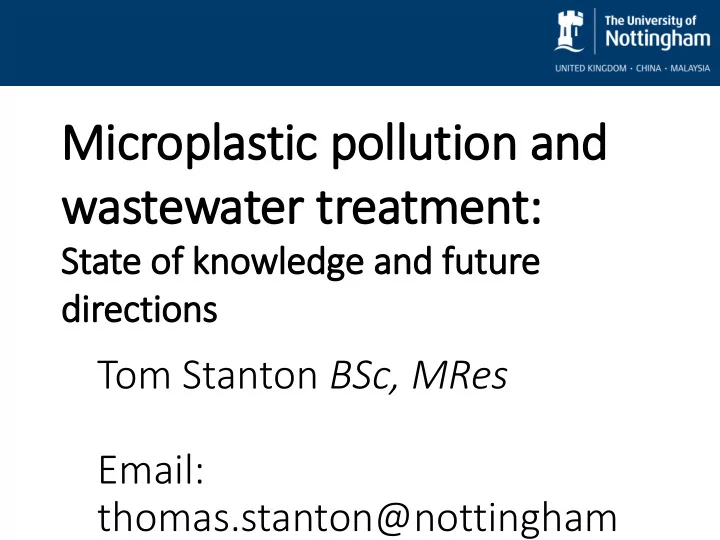

Microplastic ic poll llution and wastewater treatment: State of knowledge and future dir irections Tom Stanton BSc, MRes Email: thomas.stanton@nottingham
Overview • What are microplastics? • Microplastics and the wastewater treatment process (1) • Microplastics and the wastewater treatment process (2) • Identification of Microplastics • What am I doing?
What is a microplastic? Microplastic Particles: • Particles of synthetic plastic material no greater than 5 mm in their largest dimension. • Synthetic textile fibres (Napper and Thompson, 2016). 1 mm 500 µm
Microplastics and the wastewater treatment process (1) Outflows and Outflows and outputs outputs WWTP facility WWTP facility Emission to Influent Influent receiving waters Emission to Emission to Land Land Figure 1: An illustration of the fate of microplastic particles of different densities during the wastewater treatment process Figure 1: An illustration of the fate of microplastic particles of different densities during the wastewater treatment process Microplastics that are dense enough to settle are periodically removed from settling tanks along with other settled solids Microplastics that are dense enough to settle are periodically removed from settling tanks along with other settled solids Microplastics that float are scraped from the surface of settling tanks before being mixed with the settled solids Microplastics that float are scraped from the surface of settling tanks before being mixed with the settled solids Microplastics that remain in suspension may escape further treatment filters, such as those used in tertiary treatment Microplastics that remain in suspension may escape further treatment filters, such as those used in tertiary treatment plants, contaminating WWTP effluent and being introduced directly to a WWTP’s receiving waters. plants, contaminating WWTP effluent and being introduced directly to a WWTP’s receiving waters.
Microplastics and the wastewater treatment process (1) Dominant size range Study Liquid fraction Murphy et al. (2016) 598 µm (±89)* Microplastic removal Study Treatment level Mintenig et al. (2017) 50-100 µm (59%) from wastewater (%) Talvitie et al. (2017) 20-100 µm (70%) Murphy et al. 98.4 Secondary * Dominant size range not expressed. Data (2016) presented is instead the mean particle size. Mintenig et 97 Tertiary al. (2017) Talvitie et al. Liquid fraction 97 Tertiary Dominant (2017) Study polymer Particles (%) Fibres (%) Murphy et al. (2016) Polyester 81.5 18.5 Mintenig et al. (2017) Polyethylene N/A N/A Talvitie et al. (2017) Polyethylene >70 <30
Microplastics and the wastewater treatment process (2) Outflows and outputs WWTP facility Emission to Influent receiving waters Emission to Land Figure 1: An illustration of the fate of microplastic particles of different densities during the wastewater treatment process Microplastics that are dense enough to settle are periodically removed from settling tanks along with other settled solids Microplastics that float are scraped from the surface of settling tanks before being mixed with the settled solids Microplastics that remain in suspension may escape further treatment filters, such as those used in tertiary treatment plants, contaminating WWTP effluent and being introduced directly to a WWTP’s receiving waters.
Microplastics and the wastewater treatment process (2) WWTP facility ~18% Incineration <2% ‘Other’ ~20% Disposed of <1% Landfill and ‘other’ ~80% Reused DEFRA (2012) ~79% Agriculture
Microplastics and the wastewater treatment process (2) What don’t we know? Dominant size range Study Liquid fraction Solid Fraction Murphy et al. (2016) 598 µm (±89)* 1342 µm (±519)* Mintenig et al. (2017) 50-100 µm (59%) N/A Talvitie et al. (2017) 20-100 µm (70%) N/A * Dominant size range not expressed. Data presented is instead the mean particle size Liquid fraction Solid fraction Study Dominant Particles Fibres Dominant Particles Fibres polymer (%) (%) polymer (%) (%) Murphy et al. (2016) PES 81.5 18.5 PES N/A N/A Mintenig et al. (2017) PE N/A N/A N/A N/A N/A Talvitie et al. (2017) PE >70 <30 N/A N/A N/A
Microplastics and the wastewater treatment process (2) Why should we care? Surface runoff
Microplastics and the wastewater treatment process (2) Why should we care? Ingestion and bioaccumulation
Microplastics and the wastewater treatment process (2) Why should we care? Transportation Lwanga et al. Maaß et al. (2017) (2017)
Identification of Microplastics FTIR Spectroscopy ATR-FTIR spectroscopy (a) Reflectance and (b) transmittance FTIR spectroscopy IR detector IR source (a) Sample IR detector IR source Sample Sample (b) Crystal IR source IR detector Illustrations from Wang (2012)
Identification of Microplastics FTIR Spectroscopy FPA-FTIR spectroscopy Tagg et al. (2015)
What am I doing? Reflectance FTIR microscopy and microplastic analysis PerkinElmer Inc. (2015)
What am I doing? Microplastics in soils Rillig et al. (2017)
What am I doing? Microplastics in the atmosphere Dris et al. Dris et al. Dris et al. (2015) (2016) (2017)
What am I doing? Microplastics in the atmosphere 0.06 mm 0.06 mm 0.25 mm 0.08 mm 0.04 mm
What am I doing? Microplastics in the atmosphere (c) (a) (d) (b) (e) Reflectance FTIR spectra of five brightly coloured particles observed on filter papers from the vacuum filtration of atmospheric deposition collected across the University of Nottingham’s UK campuses. The red bands correspond to the wave ranges used by Löder et al. (2015) in their identification of microplastic particles using FPA-FTIR spectroscopy.
What can be done?
What can be done? Can the WWT industry monitor 1) microplastic pollution alongside chemical pollutants? Do different tertiary treatment 2) methods influence effluent microplastic loads? Can microplastics be removed 3) from biosolids, and how can they then be disposed of?
Thank you! Any questions? Email: thomas.stanton@nottingham.ac.uk Please ask for a list of references
Recommend
More recommend